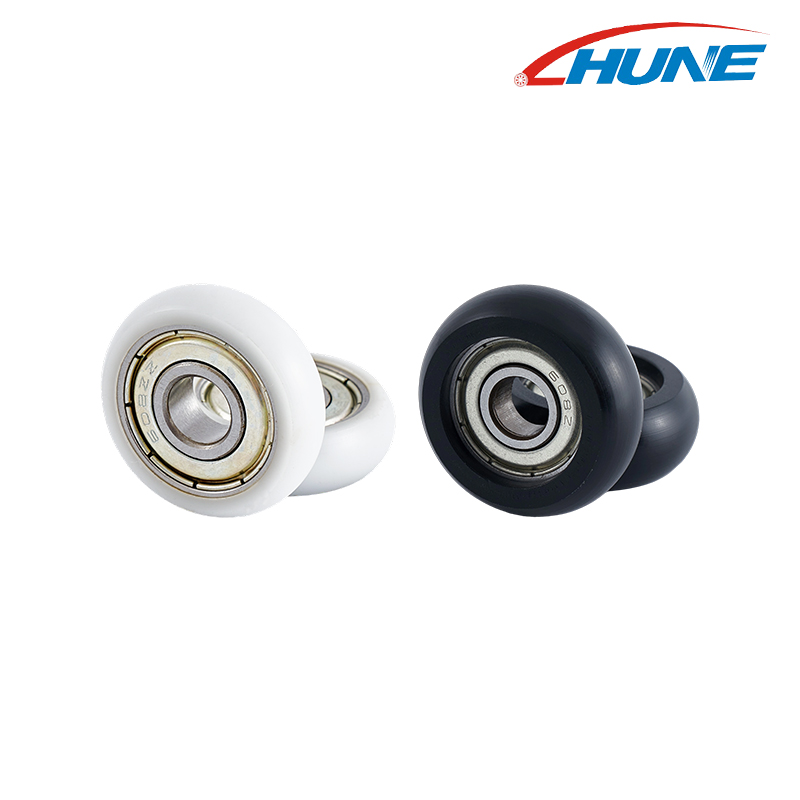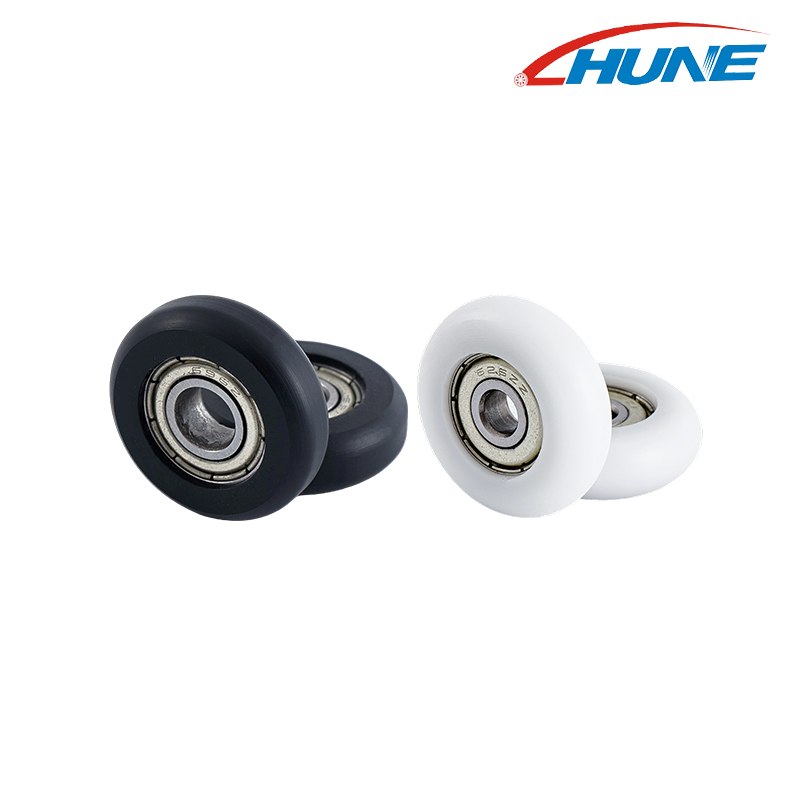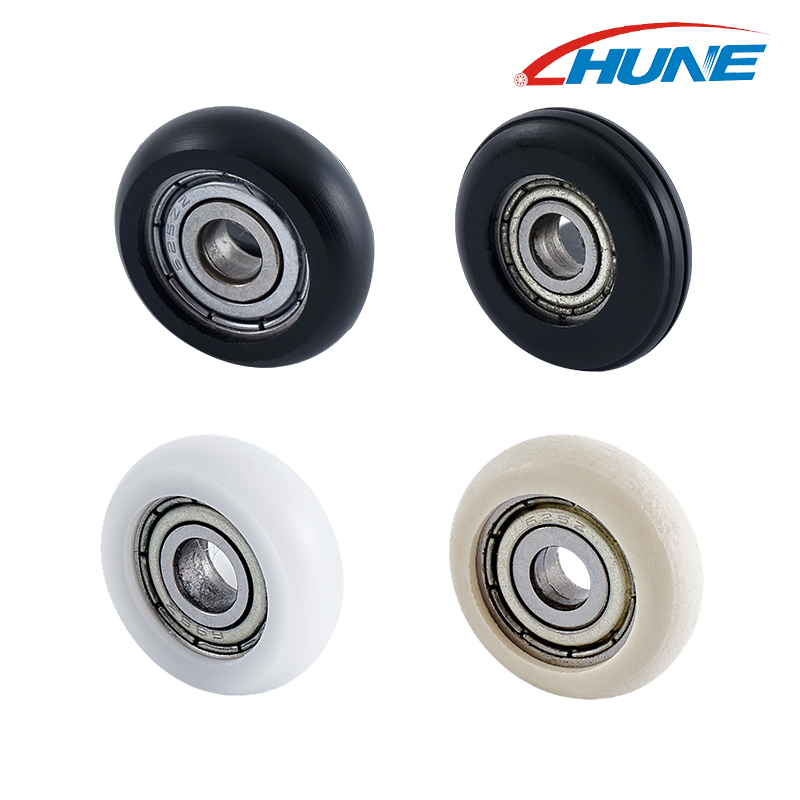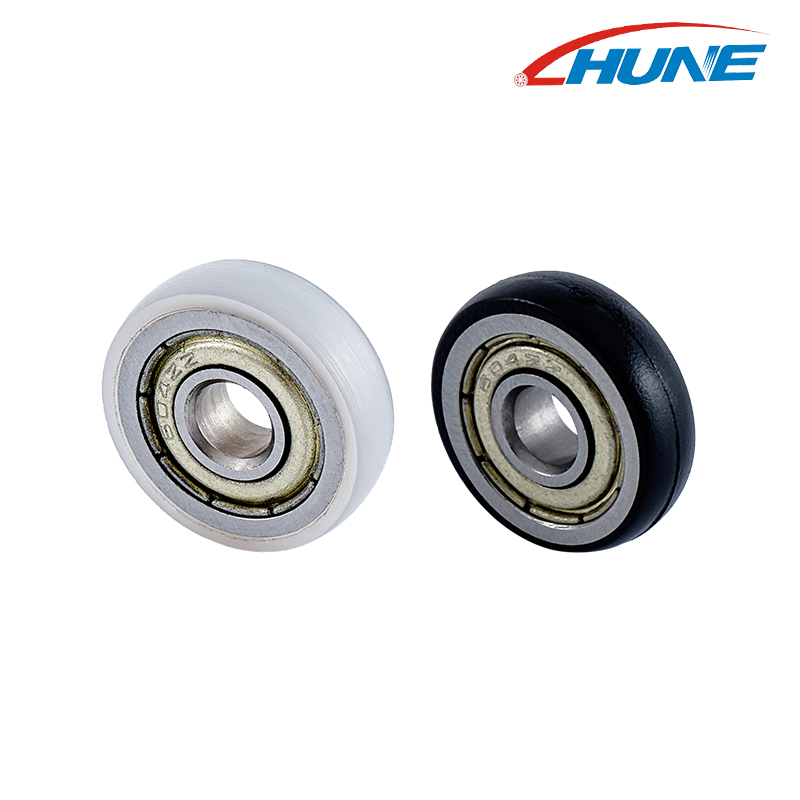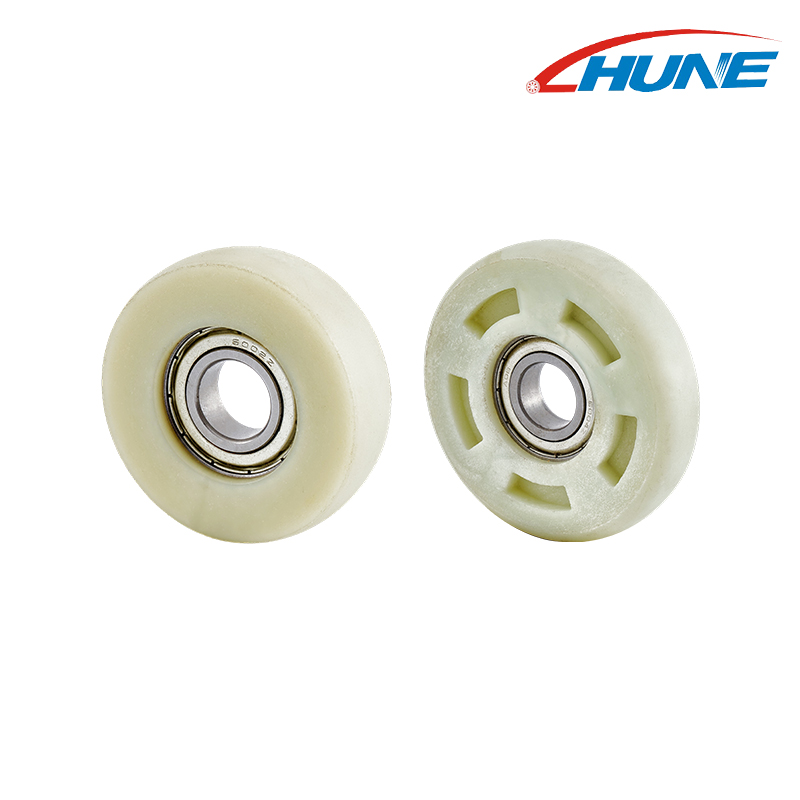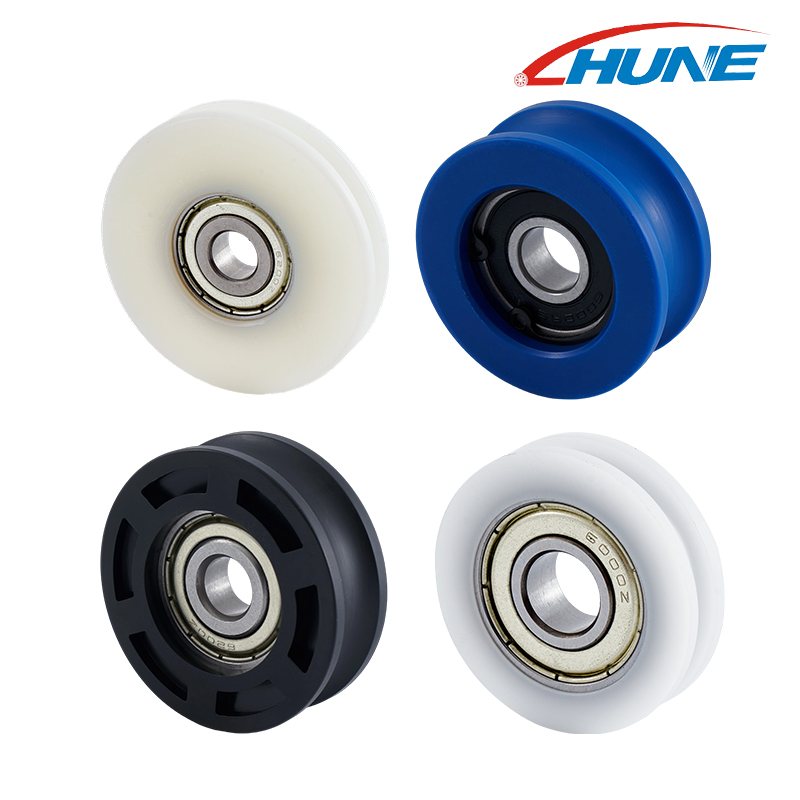A ball bearing pulley wheel is a type of pulley equipped with ball bearings, which are small spherical components that reduce friction within the wheel's mechanism. Pulleys are commonly used in mechanical systems to change the direction of force, transfer motion, or lift heavy loads, and the addition of ball bearings significantly enhances their efficiency.
The basic structure of a ball bearing pulley consists of a wheel (often made of materials like stainless steel, aluminum, or nylon) and an array of ball bearings housed within a circular track. The ball bearings enable smooth and frictionless rotation of the pulley wheel, allowing it to spin freely with minimal resistance.
When force is applied to a rope or cable passing through the pulley, the wheel rotates, and the ball bearings within the system reduce the friction between the wheel and the axle. This results in less wear and tear on the parts and a smoother operation overall. The bearings also help distribute the load evenly, ensuring a longer lifespan for both the pulley wheel and the connected components.
The functionality of ball bearing pulleys makes them ideal for applications where high efficiency and durability are required, such as in industrial machinery, fitness equipment, DIY projects, and even marine environments.
Why Choosing the Right Ball Bearing Pulley Wheel Is Crucial?
Selecting the right ball bearing pulley wheel is essential for ensuring optimal performance, longevity, and safety in any mechanical system or project.
Smooth Operation and Efficiency
- The primary role of a ball bearing pulley wheel is to reduce friction and ensure smooth, efficient motion. A wrong selection—such as using a pulley that's too small or not rated for the required load—could result in jerky movement, excessive wear, or failure, which could halt your project or lead to costly repairs.
Load Capacity
- Each pulley wheel has a specific weight and load capacity. Overloading a pulley can lead to bending, breaking, or malfunctioning of the system. Choosing a pulley with the correct load rating ensures your system can handle the weight it is expected to carry without risk of failure. Underestimating the load can have significant consequences, especially in industrial applications.
Material Compatibility and Durability
- The material of the pulley wheel significantly impacts its durability and ability to withstand environmental conditions. For example, stainless steel pulleys are perfect for high-moisture environments, while nylon pulleys are lightweight and ideal for quieter, less demanding applications. Choosing the wrong material could lead to rust, corrosion, or premature failure, especially in harsh conditions like outdoor or marine environments.
Reduced Maintenance Costs
- When you select the correct ball bearing pulley for your project, the chances of breakdowns decrease dramatically. With less friction and stress on the bearings, the system operates longer without needing replacement parts. This not only saves you time but also reduces ongoing maintenance costs—an important consideration for both industrial and DIY applications.
Optimized Performance for Specific Tasks
- Whether you're working on a home gym equipment setup, a conveyor system, or even sailing equipment, different projects require different types of pulleys. Some systems may need high-torque pulleys for heavy lifting, while others may require light-duty pulleys for faster, lighter movement. Choosing the right pulley based on your project's unique needs ensures peak performance.
Increased Safety
- Using a mismatched pulley wheel can lead to unexpected failures, such as snapped cables or malfunctioning machinery. This could pose a significant safety risk, particularly in heavy-duty or industrial environments. The correct pulley wheel, when chosen with the right load capacity and durability, ensures safer operations, reducing the risk of accidents and enhancing overall project stability.
Why the Right Ball Bearing Pulley Matters
|
Reason |
Description |
|
Smooth Movement |
The right pulley reduces friction and ensures smooth motion. |
|
Load Capacity |
Pick a pulley that can handle the weight to avoid damage. |
|
Material Durability |
Choose the right material for the environment to prevent wear. |
|
Lower Maintenance |
A proper pulley lasts longer and cuts repair costs. |
|
Better Performance |
Use the right pulley for the job to ensure efficiency. |
|
Safety |
The right pulley prevents malfunctions and improves safety. |
Types of Ball Bearing Pulley Wheels, Key Features, and Differences Explained
Types of Ball Bearing Pulley Wheels
a) Flat Pulley
A flat pulley is one of the most basic and widely used pulley types. It has a simple, flat surface that allows for a steady motion and is often used in low-torque applications.
Main Features:
- Simple design, often made of steel or aluminum.
- Primarily used for light to medium loads.
- Common in domestic appliances, DIY projects, and basic conveyor systems.
b) Grooved Pulley
The grooved pulley features a V-shaped groove that helps to secure a belt and guide its movement along a specific path. This type is commonly used in systems requiring high levels of traction, such as automotive engines and power transmission systems.
Main Features:
- V-shaped groove for better belt alignment and grip.
- Typically used for higher torque and heavier loads.
- Common in industrial settings, engines, and power generation.
c) Sheave Pulley
A sheave pulley is often used in block and tackle systems or lifting mechanisms. These pulleys are designed to run along a rope or chain and are typically used to lift heavy loads with minimal effort.
Main Features:
- Primarily designed to run on cables or chains.
- Used in lifting, hoisting, and rigging systems.
- Ideal for heavy-duty lifting and load distribution.
d) Idler Pulley
An idler pulley is a type of pulley used to guide or tension a belt within a system without driving the belt. They are commonly used to maintain tension in a system, such as in conveyor belts or vehicle serpentine belts.
Main Features:
- Non-driving pulley used to maintain tension or change direction of belts.
- Helps reduce wear and increase belt life.
- Often found in conveyor systems and car engines.
Main Characteristics of Ball Bearing Pulley Wheels
Regardless of the type, all ball bearing pulleys share a set of key characteristics that make them highly efficient and reliable:
- Friction Reduction: The most important feature of a ball bearing pulley wheel is its ability to minimize friction, allowing for smoother, faster, and more efficient movement in mechanical systems.
- Load-Bearing Capacity: These pulleys are designed to carry varying weights, depending on the material and design. The ball bearings inside allow for high load capacity without compromising on efficiency.
- Durability and Longevity: The ball bearings used in these pulleys reduce wear and tear, allowing them to last longer even in heavy-duty applications.
- Quiet Operation: Ball bearing pulleys reduce noise levels in mechanical systems by minimizing friction, which makes them ideal for applications where noise control is critical.
- Versatility: Available in various sizes and materials, ball bearing pulleys can be tailored for different applications, from light-duty to heavy-duty, making them highly adaptable.
Differences Between the Types of Ball Bearing Pulley Wheels
The primary difference between these pulleys lies in their design, purpose, and the environments in which they are used.
|
Feature |
Flat Pulley |
Grooved Pulley |
Sheave Pulley |
Idler Pulley |
|
Design |
Simple, flat surface |
V-shaped groove for belts |
Runs on ropes or chains |
Non-driving, guides belt |
|
Use Case |
Light to medium loads |
High-torque, power systems |
Lifting, hoisting, rigging |
Belt tension, guiding |
|
Load Capacity |
Low to medium |
High |
Very high |
Low to medium |
|
Material |
Steel, aluminum |
Steel, aluminum |
Steel, cast iron |
Steel, plastic |
|
Applications |
Domestic, DIY, conveyors |
Industrial, automotive |
Heavy-duty lifting |
Conveyors, engines |
Key Factors to Consider Before Purchasing a Ball Bearing Pulley Wheel
When it comes to selecting a ball bearing pulley wheel for your mechanical system or project, making the right choice is crucial to ensure optimal performance, durability, and safety. Whether you're working on a DIY project, industrial machinery, or any other application, understanding the key factors to consider will help you avoid potential issues and maximize efficiency.
Load Capacity
- The load capacity is one of the most critical factors when choosing a ball bearing pulley wheel. Each pulley is designed to handle a specific amount of weight, and overloading it can lead to wear, deformation, or even failure.
Why It Matters:
- If the pulley is not rated for the required load, it can fail prematurely.
- Choosing the correct load capacity ensures the pulley can handle the weight without risk of malfunction.
Tip: Always check the load rating specified by the manufacturer and match it with the expected load your system will experience.
Material Selection
The material of the pulley wheel significantly impacts its strength, durability, and resistance to environmental factors such as moisture, chemicals, and temperature extremes.
Common materials include:
- Steel: Strong, durable, and ideal for heavy-duty applications.
- Aluminum: Lightweight and corrosion-resistant, perfect for lighter loads.
- Nylon: Quiet operation and corrosion-resistant, great for less demanding applications.
Why It Matters:
- Selecting the wrong material could lead to corrosion, wear, or breakdown of the pulley, especially in harsh environments like outdoors or near chemicals.
Tip: Choose a material that matches the environmental conditions your pulley will face—stainless steel for corrosive environments, nylon for quieter, lighter-duty tasks.
Pulley Size and Type
The size and type of the ball bearing pulley wheel are essential in determining how well it fits into your system. A pulley that is too small or too large for the system can cause inefficiency or even damage other components.
Types of Pulleys:
- Flat Pulley: Best for simple, light-duty systems.
- Grooved Pulley: Ideal for systems that require high traction.
- Sheave Pulley: Used in lifting systems or applications involving ropes and chains.
- Idler Pulley: Maintains tension and guides belts without driving them.
Why It Matters:
- Size compatibility ensures smooth operation without unnecessary strain on your system.
- Choosing the correct pulley type based on the application ensures optimal performance.
Tip: Verify the dimensions and compatibility with your system's setup. Consider the groove type (if needed) and match it to the belt or rope you’ll use.
Environmental Conditions
- Understanding the conditions under which the pulley will operate is vital to selecting the right one. For example, if the pulley will be exposed to moisture, extreme temperatures, or chemicals, you need a material that can withstand such conditions.
Why It Matters:
- Operating in extreme environments without proper material could lead to premature wear or failure.
- Consider corrosion-resistant materials if used in wet or chemical-prone environments.
Tip: If your pulley will be used outdoors or in high-humidity areas, opt for materials like stainless steel or nylon that resist corrosion.
Bearing Type and Performance
The bearing inside the pulley plays a crucial role in its overall performance, especially in terms of smooth operation and friction reduction.
Types of Bearings:
- Ball Bearings: Offer smooth operation and are ideal for high-speed or heavy-duty applications.
- Needle Bearings: Provide support for lighter loads and are more compact.
- Roller Bearings: Used for high-load applications.
Why It Matters:
- A high-quality bearing ensures longer lifespan, smoother operation, and reduces friction and wear on the system.
- The bearing type you choose affects the speed, load capacity, and maintenance needs of the pulley.
Tip: Choose ball bearings for high-speed and high-load applications where smooth, efficient performance is essential.
Maintenance Requirements
- Every pulley will require maintenance, but some require more frequent attention than others. When selecting a ball bearing pulley wheel, consider how much maintenance the system will need over time.
Why It Matters:
- Minimal maintenance reduces downtime and maintenance costs.
- Choosing the right pulley reduces wear on the system and increases operational efficiency.
Tip: If you want a low-maintenance solution, consider sealed ball bearings or pulleys with lubricated bearings that require less frequent maintenance.
Cost vs. Quality
- While it might be tempting to choose the cheapest option available, quality should always come first, especially when dealing with components like ball bearing pulley wheels. Lower-cost pulleys may be made from inferior materials or lack the load capacity you need.
Why It Matters:
- Cheap pulleys might fail sooner, causing system downtime and expensive repairs.
- Investing in a quality pulley can save you money in the long run by reducing maintenance and increasing durability.
Tip: Compare prices, but prioritize quality and performance over cost to avoid long-term issues.
Essential Considerations for Choosing the Right Ball Bearing Pulley Wheel
|
Key Takeaways |
Detailed Information |
|
Load Capacity |
Ensure the pulley can handle the expected weight. Overloading can cause premature failure.
|
|
Material Selection |
The material impacts strength, durability, and environmental resistance. · Steel: Strong, durable, for heavy-duty use. · Aluminum: Lightweight, corrosion-resistant, for lighter loads. · Nylon: Quiet, corrosion-resistant, for low-demand applications. Tip: Choose materials based on environmental factors (e.g., stainless steel for corrosive environments, nylon for quiet operation). |
|
Pulley Size and Type |
Correct size and type ensure efficient system operation. · Flat Pulley: Simple, light-duty applications. · Grooved Pulley: High-traction systems. · Sheave Pulley: For lifting systems or rope/chains. · Idler Pulley: Maintains belt tension. Tip: Verify dimensions and ensure compatibility with your system. |
|
Environmental Conditions |
Consider the operating environment (e.g., moisture, temperature extremes, chemicals).
|
|
Bearing Type and Performance |
Bearings affect smooth operation and longevity. · Ball Bearings: Smooth, high-speed applications. · Needle Bearings: Compact, for lighter loads. · Roller Bearings: For high-load applications. Tip: Use ball bearings for high-speed and high-load tasks for smoother performance. |
|
Maintenance Requirements |
Some pulleys require more frequent maintenance than others.
|
|
Cost vs. Quality |
While cheaper pulleys are tempting, they often have lower quality and performance.
|
The Ultimate Guide to Maintaining the Long-Term Performance of Ball Bearing Pulley Wheels
When it comes to ensuring the longevity and optimal performance of your ball bearing pulley wheel, maintaining the system is just as important as selecting the right components. Proper maintenance ensures minimal wear, extended service life, and peak efficiency in your operations.
Key Factors in Ball Bearing Pulley Wheel Maintenance
Regular Inspection for Wear and Tear
Over time, ball bearing pulley wheels can experience wear and tear, especially in high-load or high-speed applications. Regular inspection of the bearings and pulley wheel is essential to spot signs of degradation, such as:
- Noise or irregular movement
- Visible wear on the grooves or pulley wheel surface
- Excessive vibration
Tip: Perform visual checks monthly to ensure everything is running smoothly. If you notice any abnormalities, it's time to replace the worn components before they fail.
Lubrication
Lubrication plays a critical role in reducing friction and preventing premature wear on the bearings. When the bearings are well-lubricated, they operate more smoothly and with less heat buildup, leading to a longer lifespan.
Tip: Use high-quality, appropriate lubricants as specified by the manufacturer. Sealed or lubricated ball bearings can reduce the frequency of lubrication, but regular reapplication may still be required depending on operational conditions.
Protecting Against Harsh Environments
Ball bearing pulley wheels are often used in environments with extreme temperatures, moisture, or exposure to chemicals. Exposure to these elements can cause rust, corrosion, and wear. To ensure that your pulley system operates efficiently in harsh environments, consider:
- Using corrosion-resistant materials like stainless steel or nylon.
- Installing covers or shields to protect the pulley and bearings from dust, dirt, and moisture.
- Ensuring proper sealing to keep contaminants out of the bearing.
Tip: If your pulley is used outdoors or in a humid environment, opting for pulleys made of stainless steel or nylon can prevent rust and degradation.
Load Capacity Management
Overloading a pulley can cause strain on the system and lead to premature failure of the bearings and pulley. Make sure that the load applied is within the load capacity rating specified by the manufacturer. Overloading can cause deformations and inefficiencies in the system.
Tip: Always check the load rating for your specific ball bearing pulley wheel before installation and during operation to prevent overloading.
Cleaning the Pulley System
Dirt, debris, and other contaminants can accumulate on your pulley system over time, leading to friction, overheating, and reduced efficiency. Keeping the pulley clean is essential for smooth operation.
Tip: Clean your pulley regularly, especially in environments where dust and debris are present. Use a non-abrasive cloth to wipe the pulley and avoid harsh cleaning agents that might damage the material.
Replacement of Worn Components
Bearings, pulleys, and other parts wear out with use. Regularly check the bearing type and overall condition of the system. If the bearings are worn, it’s essential to replace them to avoid system failure.
Tip: For low-maintenance systems, consider sealed ball bearings, which require less frequent replacement and maintenance.
Why Choose Hune Ball Bearing Pulley Wheels?
When selecting the right ball bearing pulley wheel for your system, it's crucial to prioritize quality, performance, and longevity. Hune offers a reliable range of ball bearing pulley wheels that are designed with durability in mind.
Why Hune Ball Bearing Pulley Wheels?
|
Feature |
Description |
|
High-Quality Materials |
Hune uses premium materials like stainless steel, aluminum, and nylon, ensuring durability in harsh conditions. |
|
Advanced Bearing Technology |
Equipped with ball bearings to reduce friction, Hune pulleys offer smoother operation and longer lifespan. |
|
Corrosion Resistance |
Designed with corrosion-resistant materials, Hune pulleys excel in high-humidity or chemical environments. |
|
Customization for Specific Needs |
Hune provides a variety of pulley types and sizes, ensuring the right fit for both light-duty and heavy-duty applications. |
|
Minimal Maintenance Needs |
With sealed bearings and lubricated systems, Hune pulleys require less maintenance, reducing downtime and repair costs. |
Choosing the right ball bearing pulley wheel is essential for maintaining the efficiency and longevity of your system. By following the proper maintenance tips—such as regular inspections, lubrication, and protecting your pulleys from harsh environmental conditions—you can ensure that your pulley wheels continue to perform at their best.
When it comes to quality, durability, and performance, Hune Ball Bearing Pulley Wheels are the smart choice. With a focus on high-quality materials, advanced bearing technology, and minimal maintenance, Hune offers a solution that will serve your system for the long term.






 English
English  Español
Español  日本語
日本語 